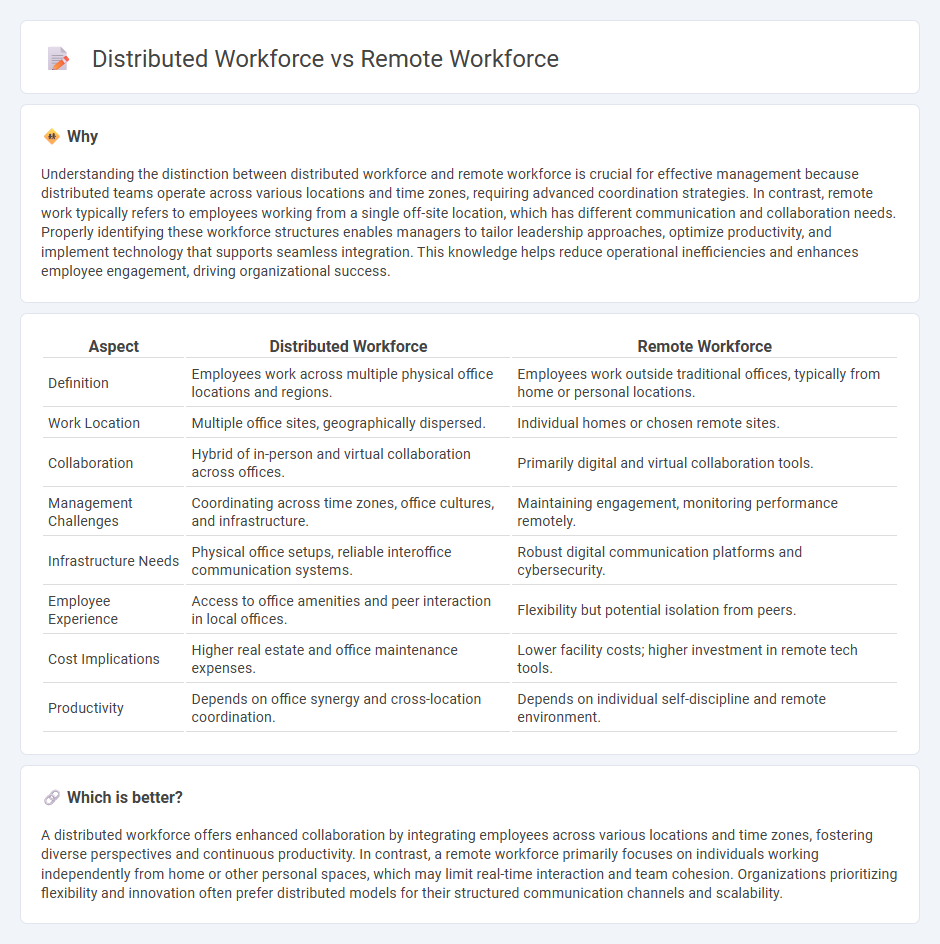
Distributed workforce refers to teams spread across multiple geographic locations working collaboratively using digital tools, whereas remote workforce typically consists of employees working outside the traditional office, often from home. Both models leverage technology for communication and productivity but differ in their organizational structure and geographic dispersion. Explore the unique advantages and challenges of each workforce model to optimize management strategies.
Why it is important
Understanding the distinction between distributed workforce and remote workforce is crucial for effective management because distributed teams operate across various locations and time zones, requiring advanced coordination strategies. In contrast, remote work typically refers to employees working from a single off-site location, which has different communication and collaboration needs. Properly identifying these workforce structures enables managers to tailor leadership approaches, optimize productivity, and implement technology that supports seamless integration. This knowledge helps reduce operational inefficiencies and enhances employee engagement, driving organizational success.
Comparison Table
| Aspect | Distributed Workforce | Remote Workforce |
|---|---|---|
| Definition | Employees work across multiple physical office locations and regions. | Employees work outside traditional offices, typically from home or personal locations. |
| Work Location | Multiple office sites, geographically dispersed. | Individual homes or chosen remote sites. |
| Collaboration | Hybrid of in-person and virtual collaboration across offices. | Primarily digital and virtual collaboration tools. |
| Management Challenges | Coordinating across time zones, office cultures, and infrastructure. | Maintaining engagement, monitoring performance remotely. |
| Infrastructure Needs | Physical office setups, reliable interoffice communication systems. | Robust digital communication platforms and cybersecurity. |
| Employee Experience | Access to office amenities and peer interaction in local offices. | Flexibility but potential isolation from peers. |
| Cost Implications | Higher real estate and office maintenance expenses. | Lower facility costs; higher investment in remote tech tools. |
| Productivity | Depends on office synergy and cross-location coordination. | Depends on individual self-discipline and remote environment. |
Which is better?
A distributed workforce offers enhanced collaboration by integrating employees across various locations and time zones, fostering diverse perspectives and continuous productivity. In contrast, a remote workforce primarily focuses on individuals working independently from home or other personal spaces, which may limit real-time interaction and team cohesion. Organizations prioritizing flexibility and innovation often prefer distributed models for their structured communication channels and scalability.
Connection
Distributed workforce and remote workforce both revolve around decentralizing traditional office environments, enabling employees to work from various locations outside a central headquarters. These models leverage digital communication tools and cloud-based platforms to maintain collaboration, productivity, and management oversight regardless of physical distance. Effective management strategies focus on optimizing performance, ensuring clear communication, and fostering team cohesion within these flexible work structures.
Key Terms
Centralization
A remote workforce operates from various locations but often relies on centralized management and communication systems to maintain coordination. In contrast, a distributed workforce functions with decentralized decision-making and localized autonomy, promoting flexibility and faster response times. Explore the benefits and challenges of each model to optimize your organizational structure.
Collaboration Tools
Remote workforce relies heavily on collaboration tools like Slack, Zoom, and Microsoft Teams to maintain communication and productivity despite physical distance. Distributed workforce utilizes these tools more strategically, integrating project management platforms such as Asana or Trello to coordinate across multiple time zones and locations effectively. Explore the best collaboration tools to optimize your remote or distributed team's efficiency and connectivity.
Autonomy
A remote workforce operates independently from a central office, allowing employees to work from any location with high levels of individual autonomy and flexibility. In contrast, a distributed workforce is structured across multiple fixed locations or hubs, balancing autonomy with coordination among distinct teams. Explore how autonomy shapes productivity and engagement in these workforce models to optimize your organization's strategy.
Source and External Links
Remote Workforce: Why It Matters and How To Manage One - This article discusses the shift towards remote work, its benefits, and strategies for effective management of remote teams.
What is a Remote Workforce? - This page defines a remote workforce and highlights its benefits for businesses, including increased productivity and cost savings.
Remote Workforce Management: The Guide to Success - This guide provides insights into managing remote employees effectively, focusing on communication, processes, and technology.
 dowidth.com
dowidth.com